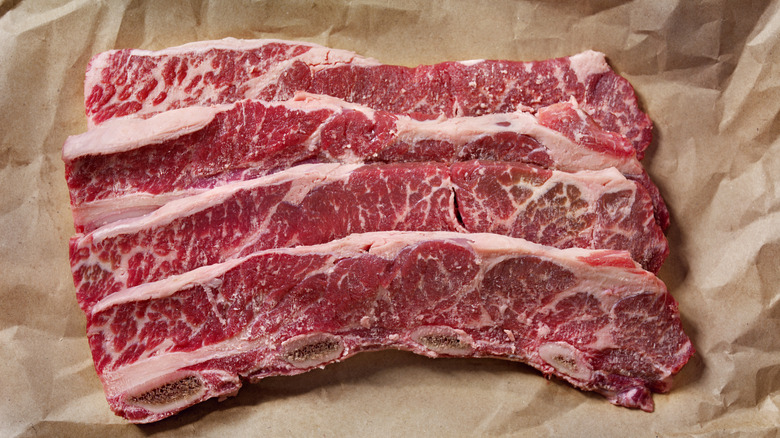How To Get The Best Short Ribs For Your Money, According To Ina Garten
Braised short ribs are the perfect comforting dish for Sunday dinners, impressing guests, or if you just want a special meal to warm you up. They are an excellent choice if you're hosting since the meal can feed a large group and is mostly hands-off. Celebrity chef Ina Garten uses strategic prep to give the illusion of more meat from her short ribs. With short ribs coming in at nearly $8 a pound and recipes like Garten's calling for five pounds of short rib meat, being able to make your ingredients serve more people is key. With rising grocery prices due to inflation, learning to stretch your ingredients without sacrificing quality is a must.
Garten makes this work by cutting her short ribs into two-inch chunks. This allows the meat to be more dispersed throughout the dish and ensures a chunk of meat in every bite. This gives the illusion that there's more meat in the dish than there actually is and makes for a more satisfying meal. Cutting the short ribs into small chunks also allows the meat to cook faster and develop that melt-in-your-mouth texture that braised short ribs are known for.
How to choose the best short ribs
Ina Garten recommends choosing "very meaty" short ribs according to her recipe for red-wine braised short ribs. When you go to the grocery store, look for short ribs that have at least an inch and a half of meat on top of the bone. This amount is a good indication that you'll be getting mostly meat as opposed to fat. Having some fat on your short rib is important for the flavor and texture of your dish. When you look at your short ribs, check for a thin layer of fat at the top of the rib. You also want to see consistent, thin marbling throughout the meat. This ensures your ribs won't end up tough and chewy.
Beef short ribs have three cut variations that are most commonly used in braised short rib dishes. You'll most likely end up with back ribs, plate short ribs, or chuck short ribs. The names stem from where the meat is located on the animal and have differing levels of quality. Oftentimes, you won't get to see the official variation at the grocery store. To ensure you get the best cut of meat for your purposes, try talking to your local butcher or meat vendor to get a better understanding of what you're buying.

